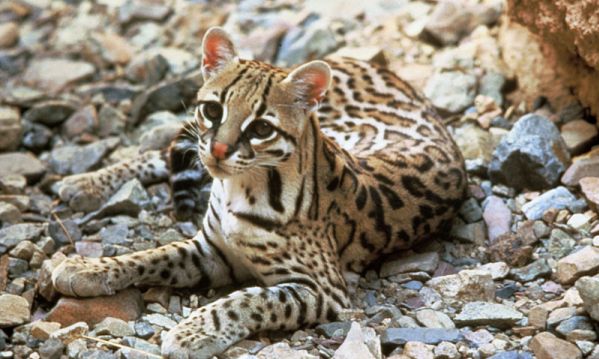Mexico - The Creator has blessed Mexico with a great variety of plant and animal life, the country's collection of flora and fauna being among the most diverse in the world. It's estimated that Mexico is home to over 200,000 species, which would account for 10-12% of the entire planet's biodiversity. The Ecology Fund puts Mexico in one of the top five countries for biological diversity.
Mexico has the world's most diverse collection of reptiles, with 717 known reptile species. Of those 717 species, 574 of them are only found in Mexico.
Mexico is the #2 country in the world in diversity of mammals, with 502 species, and #4 in amphibians, with 290 known species.
Mexico is home to 290 bird species, with 1,150 avian varieties.
As far as plants go, Mexico is #4 worldwide in flora, with 26,000 known species.
As everywhere under human jurisdiction, however, there are problems with the environment that could cause some species to become extinct or to disappear from Mexican territory.
Legally speaking, there are thousands of species specifically protected by Mexican law. The "Protected Natural Areas" include biosphere reserves, national parks, natural monuments, areas of protected flora and fauna, natural resource protection areas, and species-rich diversity sanctuaries.
But just establishing protected areas is not enough; they must be enforced, which requires game rangers to protect the protected areas. Plus, habitat loss and the introduction of invasive species affect the populations of particular animals.
It also ought to be pointed out that environmental protection is closely related to economic well-being. Where there is economic prosperity, it is easier to protect the environment. On the other hand, poor people who are struggling to survive may not see the need to respect environmental laws. That means there is a close relationship between prosperity and the environment.
Regarding animals, there are a number of animals which are endangered or threatened in Mexico. These animals' disappearance from Mexican territory would be a loss to the nation, both biologically and culturally.
Following are some animal species of Mexico which are threatened or endangered. I have included links to pictures of the animals, as it's hard to appreciate an animal without seeing what it looks like.
The GOLDEN EAGLE is one of the world's biggest birds of prey, with a wingspan sometimes extending past two meters. This majestic bird is Mexico's national symbol, but although it's more common in other parts of the world (and is not endangered worldwide), nowadays it is rarely seen in Mexico.
 |
The JAGUAR is the biggest cat native to the Western Hemisphere, ranging from the United States to Argentina, and its conservation status in that entire area is "near threatened". Most jaguars in Mexico are located in the jungles of Chiapas and the Yucatan Peninsula. The jaguar is important in the food chain because it keeps the populations of other species in balance. The big cat's population decline in Mexico is due to loss of its habitat due to deforestation.
Other wild felines endangered or threatened in Mexico include the MEXICAN BOBCAT, the OCELOT, the TIGRILLO, the COUGAR (also called Mountain Lion or Puma) and the JAGUARUNDI.
I was once driving alone down a lonely Mexican road at night. Suddenly a strange animal darted across my path. I only got a glimpse of it, but it might have been one of these cat-like animals.
The PRAIRIE DOG, a mammal communicating by a combination of barks and yips, lives in northeastern Mexico, where it burrows out its underground colonies. This little critter has been reduced to less than 2% of its former territory and is now only found in southern Coahuila and northern San Luis Potosi. The main cause is loss of habitat, so the Pronatura organization is working with Mexican farmers to protect grassland in which the prairie dog can thrive.
The MONARCH BUTTERFLY migrates 3,000 miles between Canada and the northeastern United States to the forests of Michoacan state in central Mexico. The threat to the monarch butterfly is illegal logging and forest fires which have decreased its habitat.
The VAQUITA ("little cow") is a type of porpoise endemic to Mexico. In fact, it can only be found in the lagoons of the Colorado River delta and the upper Sea of Cortes. (This body of water, between the Baja California peninsula and the Mexican mainland, is thought to be one of the most biologically diverse seas in the world). The vaquita has only been known to science for the past couple of decades, and is in danger of extinction. Its problem is it gets caught in fishing nets designed to catch the valuable (but also endangered) totoaba fish. The AXOLOTL is a type of salamander which is only found in Mexico City's Lake Xochimilco, a remnant of the lake system inhabited by the Aztecs. There are fewer than 1200 axolotls left.
Other endangered animals in Mexico include the MANTLED HOWLER MONKEY, the COAHUILAN BOX TURTLE (endemic to the region of Cuatrocienegas, Coahuila), the HARPY EAGLE, and the SHORT-CRESTED COQUETTE, a type of hummingbird only known to be found along one road (!) in the Mexican state of Guerrero.
Hopefully these species can be preserved in Mexico, for the benefit of the natural world and the enjoyment of human beings.
Note: I was recently a guest of Silvio Canto, Jr., on his September 3rd "Canto Talk" radio program. We discussed the PEMEX situation and the Mexican drug war, among other topics. You can listen to the interview HERE. Allan Wall is an American citizen who recently moved back to the U.S. after living, and teaching English, in Mexico for a decade and a half. Today, he continues to write articles about various aspects of Mexico and Mexican society. Some of these articles are about Mexico's political scene, history and culture, tourism, and Mexican emigration as viewed from south of the border, which you can read on his website at AllanWall.info.
Allan Wall is an American citizen who recently moved back to the U.S. after living, and teaching English, in Mexico for a decade and a half. Today, he continues to write articles about various aspects of Mexico and Mexican society. Some of these articles are about Mexico's political scene, history and culture, tourism, and Mexican emigration as viewed from south of the border, which you can read on his website at AllanWall.info.


